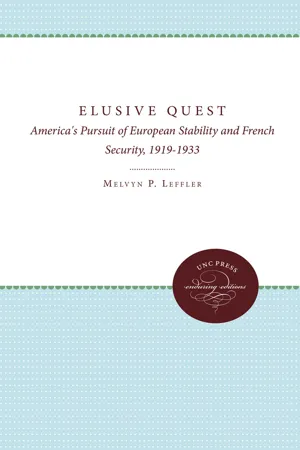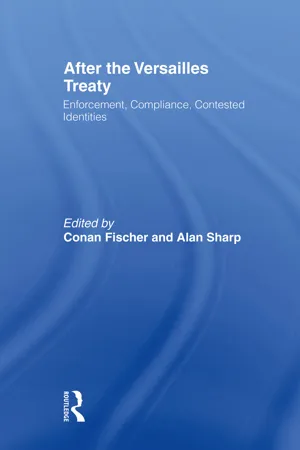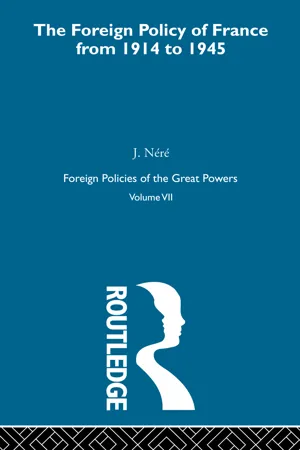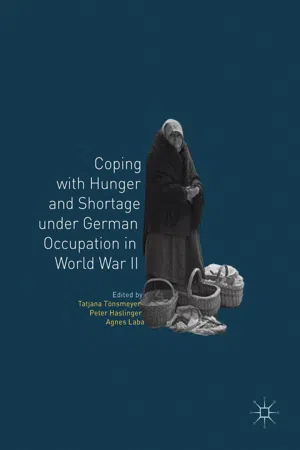History
Occupation of the Ruhr
The Occupation of the Ruhr occurred in 1923 when French and Belgian forces entered the Ruhr region of Germany to enforce reparation payments following World War I. This led to passive resistance by the German government and workers, causing economic turmoil and hyperinflation in Germany. The occupation ended in 1925 with the Dawes Plan, which aimed to stabilize the German economy.
Written by Perlego with AI-assistance
Related key terms
6 Key excerpts on "Occupation of the Ruhr"
- eBook - ePub
Experience and Memory
The Second World War in Europe
- Jörg Echternkamp, Stefan Martens, Jörg Echternkamp, Stefan Martens(Authors)
- 2010(Publication Date)
- Berghahn Books(Publisher)
Many a young Belgian had experienced the occupation of his region by German soldiers between 1914 and 1918 and then, after the signing of the Treaty of Versailles, had himself taken part in the Occupation of the Ruhr Area and the Rhineland. Twenty years later, he again found himself under the domination of a German administration. On the German side, many generations had been shaped by similar experiences, which significantly contributed to the evolution of a national identity in this border region between France and Germany. This chapter traces the conception of the occupation of the Benelux countries the Germans developed at the time. It is not primarily interested in the views of the National Socialist functional elite, but rather in the networks between administrators, historians, and other intellectuals who had an interest in these regions. Wittingly or unwittingly, these individuals took part in a thought process that facilitated German plans for the reannexation of these territories between 1940 and 1944. In this context it is important to distinguish between two levels of historical time: space of experience (Erfahrungsraum) and horizon of expectation (Erwartungshorizont) (Reinhart Koselleck). 2 The concept space of experience is particularly suitable for this analysis in that it combines two significant terms: space in its geographical and experience in its temporal connotation. Combining these two elements for the region in question, which encompasses Germany, Belgium, Luxembourg, and the Netherlands, we can discern three important aspects: the First World War, the occupation of the Rhineland and the Ruhr Area, and Westforschung. 3 Space and time are intimately interwoven here. Moreover, these aspects had multifaceted impacts on the planning and implementation of Germany'.s occupation policies in Western Europe from 1940 onwards. Three possible spaces of experience The first space of experience is the First World War - eBook - ePub
The Elusive Quest
America's Pursuit of European Stability and French Security, 1919-1933
- Melvyn P. Leffler(Author)
- 2017(Publication Date)
- The University of North Carolina Press(Publisher)
3 ]German Rehabilitation and French Security, 1923–1925
On 10 January 1923 the French and Belgian governments sent a commission of engineers and several infantry and cavalry divisions into the Ruhr to insure German payment of reparations through the supervision of state mines, forests, and other productive facilities. When the Germans responded with passive resistance, French troops moved into Germany in larger numbers, broadened the area of occupation, and established customs barriers between the occupied and unoccupied parts of Germany. The result over the next year was the economic breakdown and financial degeneration of Germany.1The French intervention in the Ruhr constituted a fundamental challenge to the foreign policy of the Harding administration. In the view of Republican officials French policy was aimed at solving French strategic and financial problems through the economic and political emasculation of Germany. With varying degrees of intensity Republican policymakers and American diplomats ridiculed this policy. They believed that the best means of guaranteeing French security and alleviating French financial difficulties was through the consummation of a moderate reparations settlement that would allow for the financial stabilization and economic rehabilitation of Germany. Disregarding the strategic ramifications of such a policy on France, Hughes insisted that “there can be no economic recuperation in Europe unless Germany recuperates. There will be no permanent peace unless economic satisfactions are enjoyed.” Both he and Hoover believed that French strategic anxieties and German economic needs could be reconciled. They assumed that a prosperous Germany would be a peaceful and republican Germany and would willingly pay a reasonable indemnity. Moreover, for Hughes and Hoover, a prosperous Germany constituted the prerequisite of the reconstruction of Europe, the revitalization of the international economy, and the creation of a viable liberal capitalist community.2 - eBook - ePub
After the Versailles Treaty
Enforcement, Compliance, Contested Identities
- Conan Fischer, Alan Sharp(Authors)
- 2013(Publication Date)
- Routledge(Publisher)
The British Zone of Occupation in the Rhineland Elspeth O’RiordanThe decisions regarding the occupation of the Rhineland after the First World War formed one part of the hugely complicated and highly political inter-allied discussions at Paris in 1919. After a brief outline of the negotiations at Paris and the formulation of the treaty clauses relating to the occupation of the Rhineland, we shall examine Treaty implementation, examining how, for the British, Rhineland occupation worked in practice between 1918 and 1923. Three specific episodes serve to illustrate the character of the occupation: events relating to the Kapp Putsch and subsequent extension of the Rhineland occupation by France (supported by Belgium) in 1920; the occupation of Frankfurt, Duisburg and Diisseldorf in response to difficulties while negotiating the London Schedule of Payments in 1921; and, finally, the impact on the British zone of the Franco-Belgian Occupation of the Ruhr in 1923.Three issues are paramount here. The first relates to the difficulties encountered in practice when attempting to implement the Treaty provisions. Secondly, the practicalities of Britain’s position as an occupying power drew her further into the minefield of European politics than policy-makers would have wished, often making her vulnerable to pressure from both France and Germany as tensions between the two increased. Finally, the practicalities of policy implementation on the ground highlighted (and indeed, on occasion, exacerbated) weaknesses and inconsistencies in Britain’s overall European policy at the political level. This resulted in a dynamic, symbolic policy-making relationship between the periphery and London. Through considering the specifics and detailed implementation of the Treaty of Versailles in this way, it is hoped to shed fresh light on the viability and wider record of the overall peace settlement. - eBook - ePub
- Nere(Author)
- 2013(Publication Date)
- Routledge(Publisher)
When the Reparations Commission had duly ascertained the German omissions in the deliveries of wood and coal on 11 January 1923, the French and Belgian governments sent an ‘Interallied Mission of Control of Factories and Mines' (MICUM) into the Ruhr. This mission consisted of a group of engineers, protected by troops, designed to guarantee the fulfilment of the pledges of production. In fact, the operation very quickly resulted in an extension of the military occupation of this region of the right bank of the Rhine.The legality of this occupation has been hotly debated. The text of the Treaty of Versailles on which it is based is as follows:The measures which the allied and associated Powers will have the right to take, in the case of voluntary omission by Germany, and which the German government undertakes not to regard as acts of hostility, can include acts of economic and financial prohibition and reprisals, and in general, other such methods as the respective governments may consider necessary in the circumstances.The occupation of territories beyond the Rhine did not then appear among the sanctions explicitly provided for. Was it, however, excluded? Legally, it seems that the Allied governments were left with very great latitude. In fact Britain had taken part in the occupation of DÜsseldorf, Duisburg and Ruhrort; on several occasions she had accepted the idea of Occupation of the Ruhr, at the same time seeking ways of delaying putting it into practice. In January 1923 Britain broke away from the operation, but she lacked a juridical basis for opposing it. Her objections developed basically on political and economic levels.c The ‘passive resistance'
Germany's reaction was clearly much more drastic. On 13 January the German government suspended all payments in kind to France and Belgium. It forbade railway officials and employees47 to obey the orders of the occupying authorities. The strike spread quickly to the private sector.47 The German railways had already been state-owned for a long time .Such was the ‘passive resistance’. The idea – like that of the Occupation of the Ruhr – had been discussed for a long time. The German nationalists saw it as a means of questioning the Treaty of Versailles as a whole. It is, however, difficult to imagine how they visualized making this weapon effective. - eBook - ePub
A Political Biography of Arkadij Maslow, 1891-1941
Dissident Against His Will
- Mario Kessler(Author)
- 2020(Publication Date)
- Palgrave Macmillan(Publisher)
At first, the inflationary thrust had a positive economic effect: While the victorious allied countries suffered from a decline in production and employment, Germany achieved almost full employment and growing production volumes. A solution to the monetary problems was not in sight, however. Inflation rose immeasurably: In January 1921, the US Dollar exchange was 15.5 Reichsmarks, a year later 45.5 Reichsmarks, in July 1922 118 Marks, and by December 1922 had reached 1810 Marks. By the autumn of 1923 the US Dollar was worth 4,210,500,000,000 Reichsmarks.In November 1922 new government was appointed under Wilhelm Cuno , chairman of the Hamburg-America Steamship Line, which was mainly composed of businessmen and experts. This new government was unable to solve the problem.1In January 1923 the Cuno government claimed that it could no longer afford the reparation payments required by the Versailles Treaty. When it defaulted on some payments, French and Belgian troops occupied the Ruhr region, Germany’s industrial heartland, taking control of most mining and manufacturing companies. French so-called punitive expeditions not only robbed banks but cordoned off main streets and robbed passers-by as well. March 1923 saw an especially long record of French brutality: shootings, thrashings, and terrorization. But the occupiers were quite unable to operate anything: By the end of March “they were getting only 1 percent of the coal that they had previously enjoyed from the Ruhr.”2The German government called for passive resistance to occupation and found support among the entire population, including KPD followers.3 Strikes were called and resistance encouraged. These strikes lasted eight months, further damaging the economy and increasing the cost of imports. The strikes meant that no goods were being produced. This infuriated the French occupation forces who began to kill and exile protestors in the region. Around 180,000 people fled their homes or were forced to flee.4The ECCI closely monitored events in Germany. It set up a special committee to coordinate illegal activities, convinced that “the party was likely to have to live clandestinely for a while.”5 According to a resolution of the ECCI Presidium, the German party had to adopt a system of communication and illegal printing in order to provide members with false papers in an attempt to occupy positions in the army and the security forces. The resolution stated: “Party members, like the rest of the working class, must realize that, in one way or another, in the short or long term, they will be forced to confront their enemies in a violent fight; it is therefore necessary to prepare them ideologically.”6 - Tatjana Tönsmeyer, Peter Haslinger, Agnes Laba, Tatjana Tönsmeyer, Peter Haslinger, Agnes Laba, Tatjana Tönsmeyer, Peter Haslinger, Agnes Laba(Authors)
- 2018(Publication Date)
- Palgrave Macmillan(Publisher)
survival chances, and affected them severely even before mass murder began. Thereby, occupation put the societies concerned under severe pressure. This in turn freed up social dynamics that directly and indirectly influenced people’s everyday lives, and set this period apart from pre-war and post-war times.Notes
- 1. Christoph Buchheim and Marcel Boldorf, ed., Europäische Volkswirtschaften unter deutscher Hegemonie 1938 –1945 (Munich: R. Oldenbourg Verlag, 2012); Adam Tooze, TheWagesof Destruction: The Making and Breaking of the Nazi Economy (London: Penguin Books, 2006); Alan S. Milward, The New Order and the French Economy (Oxford: Oxford University Press, 1970).
- 2. Christian Gerlach, Krieg, Ernährung, Völkermord. Forschungen zur deutschen Vernichtungspolitik im Zweiten Weltkrieg (Hamburg: Hamburger Edition, 1998); Christian Gerlach, Kalkulierte Morde. Die deutsche Wirtschafts - und Vernichtungspolitik in Weißrussland 1941 bis 1944 (Hamburg: Hamburger Edition, 1999); Gesine Gerhard, “Food and Genocide. Nazi Agrarian Politics in the Occupied Territories of the Soviet Union ,” Contemporary European History 18 (2009): 45–65; Dieter Pohl, Die Herrschaft der Wehrmacht. Deutsche Militärbesatzung und einheimische Bevölkerung in der Sowjetunion 1941 –1944 (Frankfurt a. M.: S. Fischer Verlag, 2011), 183–200; Wigbert Benz, Hans -Joachim Riecke. Vom Hungerplaner vor, zum “Welternährer” nach 1945 (Berlin : Wissenschaftlicher Verlag, 2014); Christoph Dieckmann and Babette Quinkert, ed., Kriegsführung und Hunger 1939 –1945. Zum Verhältnis von militärischen, wirtschaftlichen und politischen Interessen
Index pages curate the most relevant extracts from our library of academic textbooks. They’ve been created using an in-house natural language model (NLM), each adding context and meaning to key research topics.





